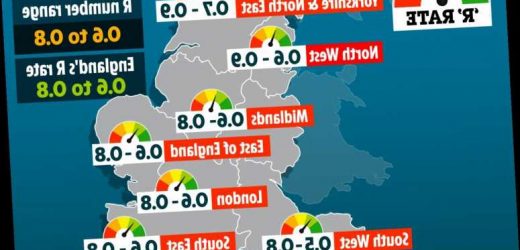BRITAIN'S official coronavirus R rate has dropped this week to its lowest level yet, official data has revealed.
The R rate – which represents the number of people an infected person will pass Covid onto – is between 0.6 and 0.8 across the UK, Sage said today.
? Read our coronavirus live blog for the latest news & updates…
Last week government scientists estimate that the R rate was between 0.7 and 0.9.
It comes as data from the ZOE Symptom Tracker App revealed that cases have fallen by 30 per cent in a week.
App data states that at present there are 5,494 new cases of the virus each day, a drop of 32 per cent from 8,111 last week.
Data published by the Office for National Statistics (ONS) today also revealed that cases are still falling across the UK.
At present, around 200,600 people have Covid across the country, this is down from 248,100 the week before.
Figures from Public Health England (PHE) released earlier this week stated that infections are falling in all regions of the country,
But data from the ONS states that there are early signs of a possible increase in the number of people testing positive in the South West and South East of the country.
Rates have decreased in the North East, North West, East Midlands, East of England and London, with the trend being uncertain in Yorkshire and The Humber and the West Midlands.
It comes as:
- Covid cases plummet by THIRD in a week as deaths tail off and expert says ‘darkest days are behind us’
- More pressure on Boris Johnson to lift lockdown sooner as Wales joins Scotland in speeding up its path to freedom
- Scientists have found a NEW bat-virus that’s 94.5% identical to Covid
- Covid jab slashes risk of spreading bug at home by 54%, new data shows
- Novavax Covid vaccine found to prevent 100% of deaths and 96% of cases with 60 million doses set for UK
When the R is below 1, it means transmission is low enough for the epidemic to shrink – but greater than 1, it suggests the outbreak is growing.
The values are shown as a range, which means the true R rate most likely lies somewhere between the upper and lower estimates.
Sage states that R is a lagging indicator and that the estimates "cannot account for the most recent policy changes, nor changes in transmission that have not yet been reflected in epidemiological data".
The data published today by Sage revealed that the North East and Yorkshire has the highest R rate in the country and is currently between 0.7 and 0.9.
Every other region is between 0.6 to 0.8 aside from the South West, which currently has an R rate between 0.5 to 0.8.
Despite the rate falling today Sage said: "Prevalence of the virus remains high, so it is vital that everyone continues to stay at home in order to keep the R value down, protect the NHS and help save lives."
One expert today said the darkest days of the pandemic could be behind us as infections continue to fall.
Professor Tim Spector said the UK's vaccine rollout has helped drive cases down.
So far in the UK over 23 million people have had a first dose of either the Pfizer/BioNTech jab or the Oxford/AstraZeneca offering with over 1.3 million having had a second.
What does R rate mean?
R0, or R nought, refers to the average number of people that one infected person can expect to pass the coronavirus on to.
Scientists use it to predict how far and how fast a disease will spread – and the number can also inform policy decisions about how to contain an outbreak.
For example, if a virus has an R0 of three, it means that every sick person will pass the disease on to three other people if no containment measures are introduced.
It's also worth pointing out that the R0 is a measure of how infectious a disease is, but not how deadly
A fall in infection rates, hospitalisations and deaths are all key when it comes to keeping Prime Minister Boris Johnson's roadmap out of lockdown on track.
une 21 is the date the Government plans to lift all Covid restrictions, subject to it being safe enough to do so.
Ministers will be measuring the impact of each step of easing lockdown before then, including schools reopening from today, allowing groups of six to meet outdoors on March 29, and the opening of hospitality in May.
There is still the possibility that cases and the R rate are too high to lift the rest of Covid rules in June.
Source: Read Full Article



